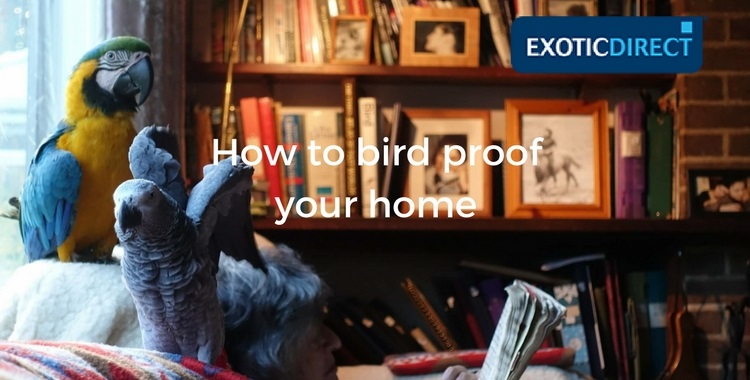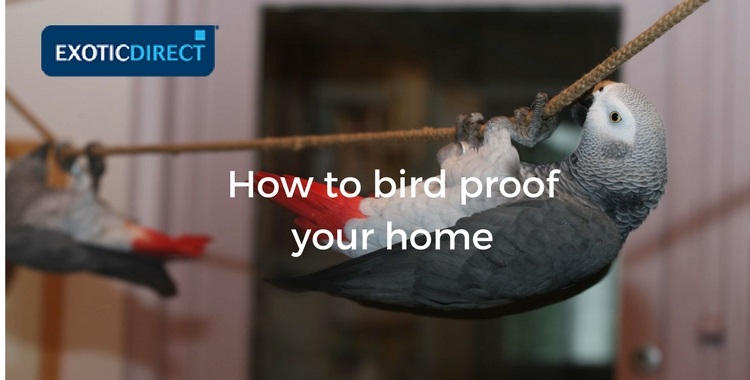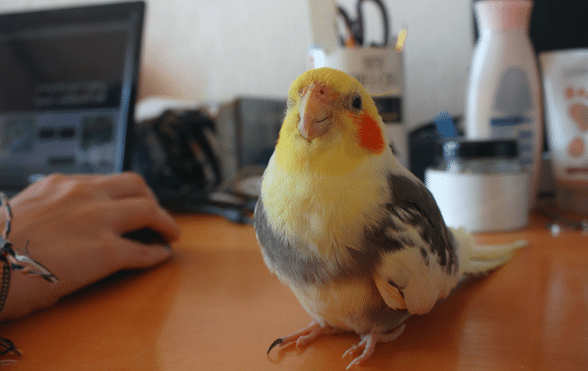How can you bird proof your home, so that its safe for your parrot? What about the kitchen, the bathroom, and other dangers like electrical wires. We answer your questions in our article.
Is your parrot insured? Get a quote for up to £5,000 of vet fee cover, death and theft cover | We’ve been insuring exotic pets since 1996 | Check out our customer reviews on Feefo.
Keeping your parrot safe in the kitchen | Keeping your parrot safe in the bathroom | Can I keep my bird in my bedroom? | Household items that are toxic to birds | Zinc and lead | Fumes and your parrot | Parrots, glass and mirrors | Smoking around parrots | Best temperature for birds | Electrical wires and parrots | Toxic plants and parrots | Safe toys for parrots | Preventing parrot escape
To keep a parrot perfectly safe indoors and enjoying many hours of “out of cage time” you need to take sensible precautions.
You may need to modify some of the rooms and windows and use different products for cooking and cleaning. The parrot needs to know a few simple commands: ‘Step up, ‘ Fly to me’ and ‘Off’.
Knowing these requests make it easier for parrots and people to live companionably and safely together.
Read my article on Teaching your parrot the ‘Step Up’ command.
Keeping your parrot safe in the kitchen
If one axiom applies to parrot husbandry it is prevention is better than cure.
Non stick pans and birds
“Your bird is safely chirruping in her cage and you are frying some onions in non-stick pan.
The phone goes. You rush to pick up and forget to turn off the heat.
The calls from an old friend so you walk into the hall to avoid the parrot who is yelling, ‘Hello ‘who’s there, who’s there?’
The onion burns to a frazzle, the non-stick coating gives off a gas. When you run back coughing with the acrid fumes and throw the pan outside – the parrot may well have succumbed to asphyxiation.”
Avian lungs are far more sensitive than humans. Remember that canaries were used to detect noxious fumes in coal mines to protect the miners. The poor canaries keeled over long before the miners were aware of gas.
Without delving too deep into tragedies, this fatal accident occurred with a group of cockatiels and in another case with an Amazon when the self-clean oven malfunctioned.
There’s a 100% safe solution – never keep parrots around in a cooking space and/or never have cooking utensils with Teflon type coatings.
But I like my parrots helping me cook. So, I make compromises. No non-stick of any sort and teach safety commands.
Not sure what to feed your parrot? Read my article on Parrot Diet and Food Ideas
Carbon monoxide and parrots
Carbon monoxide from a faulty appliance will kill you as well as the birds. A cautious householder should have a carbon monoxide detector installed.
Risk of burns and your parrot
One solution for free ranging parrots to avoid hot surfaces is to teach the ‘Off’ command. If they ignore you and still land on the hot plate, they’ll soon associate the pain with the hotplate, and you saying “off”, or “hot”.
However, prevention is better than cure, and keeping them out of the way when the cooker is on is the best solution.
Read my article on training your parrot using Positive Reinforcement
Risk of drowning and your parrot
Water deeper than a parrots’ head should never be standing in the sink. Most parrots will learn to love the dripping tap to take a drink, or start splashing once there’s enough water.
A fun thing to aid bathing is to have a spray of rain-wet leaves standing in the sink or washbowl and watch how the birds enjoy splashing. A natural way to bathe.
A parrot who drowns in a body of water indoors really only has its carer to blame.
Is your parrot insured? Get a quote for up to £5,000 of vet fee cover, death and theft cover | We’ve been insuring exotic pets since 1996 | Check out our customer reviews on Feefo.
Keeping your parrot safe in the bathroom
Vigilance is an essential quality to keep them safe in the bathroom. Parrots are in many ways like a toddler except that they have a tin opener on their face. You wouldn’t leave a toddler unsupervised.
-
- Toilets and parrots: Toilet lids must always be shut if no one is using them. If the family forget, a polite notice SHUT ME NOW should suffice.
-
- Baths and parrots: Many carers like their parrots to keep them company while they shower or take a bath. Even if the bird stays on the shower rail, steam is most beneficial. However, parrots can fall into the bath by accident, if you don’t keep an eye on them.
“On one bath time occasion. Artha and Casper were beaking one another on the shower rail. I was reading as usual in the bath.
I felt the water bobbing round my ankles. Ignored it; the water bobbed again. Casper had fallen off the shower rail and was submerged.
I didn’t wait to see whether or not he could swim. Dried him off with a towel and never read in the bath again if the birds were with me”.
The moral of the story is, keep an eye on them at all times.
-
- Medicines and parrots: Curiosity is a prime characteristic of pet birds, and if they can get access to your medicines, with their interesting packets, they will.
Keep them in a locked cupboard, so that your parrot can’t figure out how to get at them.
- Medicines and parrots: Curiosity is a prime characteristic of pet birds, and if they can get access to your medicines, with their interesting packets, they will.
“One bath time Artha Grey was on the window sill with an apple while I soaked in a deep bath and read Cage and Aviary.
Being deaf, I didn’t hear the noises of “parrot-doing-something-bad”. Artha had left the window sill. She had opened the cabinet door where all our pills are kept and was busily flipping pills out of their sachets. It was 10 pm on a Friday night.
I slept fearfully. In the morning, she was unharmed. Evidently popping pills was the fun; she hadn’t tried to eat any constipation pills, headache pills and the multi-vitamins were all intact
Birds love water, but you should always watch them closely.
 Your birds can play with toys, books and you.
Your birds can play with toys, books and you.
Can I keep my bird in my bedroom?
Not a hazard for us because they are not allowed in. Just bear in mind if you do sleep with your bird, are you certain you might not roll onto her?
I have slept in hotel rooms with Casper on a perch and he has stayed there.
To keep a sleep cage in the bedroom has no health risks however you’d need to ensure the bird would not get disturbed, for parrots need 10 to 12 hours uninterrupted slumber.
Household items that are toxic for birds
I avoid:
-
- Substances like bleach. I clean the aviary and bird room with solutions of F10 disinfectant. My vet uses D10 and that cannot be a higher recommendation for me.
-
- Perfume is debatable. Some people will use it; others avoid it.
- The same goes for candles and incense. I know natural scents are delectable to birds. They love being surrounded with roses or blossoms.
If you need to use any caustic preparation simply ensure the birds cannot come into contact with it and rinse the object thoroughly. It can actually become fun to see how much you can avoid harsh chemicals.
The evidence of what is noxious for birds and what isn’t, is not easily available. However, a useful spin off in keeping tabs is becoming aware that many chemicals are dangerous for them (and not especially good for us) so finding an alternative source will be good for them and for us.
Heavy metals including zinc and lead
Zinc and lead are harmful for parrots, and there is no controversy about the danger of these substances and the possible fatal harm they can cause.
When a parrot chews wire coated in zinc, she will be poisoned. And it may be fatal. Please avoid wire if you are not sure zinc might have been involved in its manufacture.
However, Zinc in minute quantities is an ingredient of pellets and other food.
Lead poisoning was a cause of infant deaths in the 19th century. If parrots ingest lead from a badly manufactured toy you may be lucky enough to save them but it is not sure.
Paint used to be a problem if it contained lead but modern paints don’t.
Fumes that can be dangerous for your bird
-
- Paint fumes and birds: Without being over cautious, you can adopt the sensible precaution of thoroughly airing any rooms where walls have been freshly painted.
-
- Insecticides: These contain chemicals lethal to insects and unpleasant to us. They should not kill birds but are best avoided. Easy to do.
When I fumigate poultry runs or aviaries against mites or other insects, I first remove the hens or birds, treat the run or cage, wait until the product smell has dissipated before bringing them back in.
- Insecticides: These contain chemicals lethal to insects and unpleasant to us. They should not kill birds but are best avoided. Easy to do.
- Wood burning fireplaces and your birds: I have never found that the smoke from our two wood burning fires bothers the birds once I had taught them not to land on the hot top surface.
 Parrots can easily play safely indoors when you’re aware of dangers.
Parrots can easily play safely indoors when you’re aware of dangers.
Parrots, Glass and Mirrors
Glass and mirrors can be a hazard and I’ve heard of accidents even fatal ones. These can be avoided.
When I was first training Artha and Casper Grey as just flighted young birds, I smeared the windows with Windolene and tapped the birds’ beaks daily against the glass.
After a few weeks, I gradually wiped off the cleaner. What shining windows! The first time I took Artha to a friend, she flew into the windows as she didn’t recognize them.
Mirrors are fun. Some birds insist that it’s another bird. Peacocks will start fighting with their reflection in a hub cap. Others quickly realize I have mirrors hanging in the aviary.
Parrots can like looking at themselves in the mirror.
Is it safe to smoke around parrots?
Cigarettes can cause fatal diseases for us. Ditto for the parrots. Just give up. Or simply freeze in the garden outside – just don’t smoke in front of them.
Food to avoid
Purists will insist no human food. EVER! I don’t think the occasional crisp or biscuit will topple Polly off her perch. But you should avoid caffeine, alcohol, chocolate, fried food and avocados.
Why not read my article: Parrot food and diet ideas.
What room temperature is best for a pet bird?
Find out what the climate range of your species is in the wild. Many centrally heated houses are too dry for most birds. Some birds like cockatiels are used to a wide range between night and day temperatures; others like Amazons or Greys live in an equatorial climate. Try to have some moisture in the air. Indoor plants are good for that.
Protecting your parrot from ceiling fans
Friends who have fans and keep birds tell me they put the bird on the stationary fan and slowly let it revolve until the parrot flies off, and they’ve found no problems.
Whereas migrating birds suffer huge losses from outdoor windmills generating electricity.
Our only fan is an upright with a metal grille.
Protecting your parrot from electrical wires
This a difficult problem to eliminate. In our bird room, the electric heater on the floor wears a jacket of thick plastic hose pipe.
The ceiling strip light has the fitting at both ends enclosed in a neat wire cage after one of the macaws sent the light to the floor (it was not broken!) In the sitting room areas, many wires are concealed behind beading.
In our rooms where parrots are allowed, all have perches and ropes across the ceiling which are hung with chewable toys. Books and birds are incompatible. You simply have to compromise. Providing them entertainment helps keep them away from items that could be dangerous.
Lily Lesser Sulphur was given her own bookcase to shred. The other birds know ‘Off’ but that doesn’t prevent them trying.
One solution of a friend that I have imitated, is to throw drapes over the furniture and electrical wires when her birds have playtime.
Houseplants that are toxic to parrots
The more plants the better in a parrot household. Certain plants soak up impurities. Parrots love to hide amongst and chew greenery. A source of leafy branches and edible flowers are a boon for the indoor bird.
You can find a lists of safe and toxic plants in our article Safe Food and Plants list for parrots.
Safe toys for parrots
Most toys you make yourself from natural finds or discarded household items like branches, fir cones, paper rolls and old books will be safe.
I make wreaths from wire hoops (be sure the hoops ends are securely fastened) covered with willow flowers and toys. I buy wooden cooking spoons cheap and desired by busy beaks.
You can read about the toys I make in my article 10 Ideas for Homemade Parrot Toys.
Toys you buy from reputable sources like Northern Parrots should be safe. Toys made in China I avoid. I often buy toys from Charity shops if they have a child/baby safe label.
My unsafe toys golden rule is that if you would not give it to a lively toddler don’t give it to your bird. Some carers avoid stuffed toys for fear of ingested stuffing materials I don’t personally
Ropes are a safe toy if you frequently inspect them for fraying. All that said I have had accidents with toys.
Perdy cockatoo got a string from a hanging toy wrapped round her leg. Casper chewed a hole in the wire aviary roof and got stuck. No accident was serious.
My worst accident in 20 years was hand feeding Mina the young Military macaw. She pumped so energetically that she swallowed the teaspoon bent in the shape of a macaw’s beak. We managed to retrieve it and no permanent harm done. One of the worst twenty minutes of my life.
Preventing your bird from escaping out the house
Parrots do escape. Walking out into the garden with a bird on your shoulders – most of us have done it. Artha flew to the bungalow roof one freezing January and waited for me to climb onto the roof tiles and retrieve her.
-
- To keep birds from flying through an open door in warm weather, we hang aluminium chains in front of exterior doors.
-
- We keep windows open less than we would like; you can fit mosquito netting in frames in front of open windows.
-
- Double doors as most aviaries have, are a boon for the indoor parrot keeper.
-
- A front door sign – Caution Birds Inside – can be useful.
-
- I would like every parrot carer to take their bird in harness or in a back pack round the district to familiarise them with the immediate environment, so that if they do escape, they at least have an idea of their bearings.
(If your bird is not harness trained, try reading my article about How to Take your Bird Outside).
-
- I am also a proponent of an outdoor aviary or a screened-in balcony. The benefits are that the bird gets fresh air (you get to sit out with her and be companiable too) and should she inadvertently one day find itself outside, she will be less terrified.
In an aviary or cage outdoors, they enjoy watching wild birds on the bird table.
For more advice on keeping your bird secure read our article: Keeping your Parrot Safe – Security and Identification.
I’m sorry if all this may seem daunting. Being vigilant will become second nature. One spin off in our parrot life is that we have to be tidier when birds are uncaged or woe to TV remotes, computer keyboards furniture or books.
If visitors, who aren’t bird people wonder why there are so many cloths shrouding books and furniture and wires, I know you’ll understand.
Is your parrot insured? Get a quote for up to £5,000 of vet fee cover, death and theft cover | We’ve been insuring exotic pets since 1996 | Check out our customer reviews on Feefo.
Resources
Poisonous and Safe Plants for Birds – Pet Education
Safe Plants and Toxic Plants for Birds list
The Parrot Society UK (if you have a parrot – join) will answer any husbandry question.
Telephone: 01442 872245 Email: les.rance@theparrotsocietyuk.org

